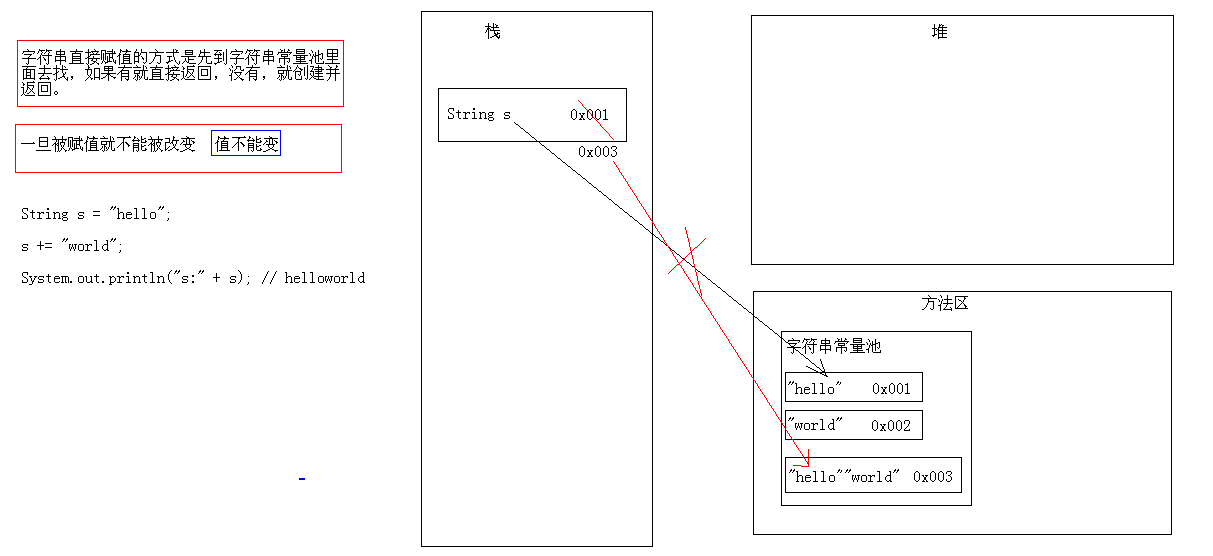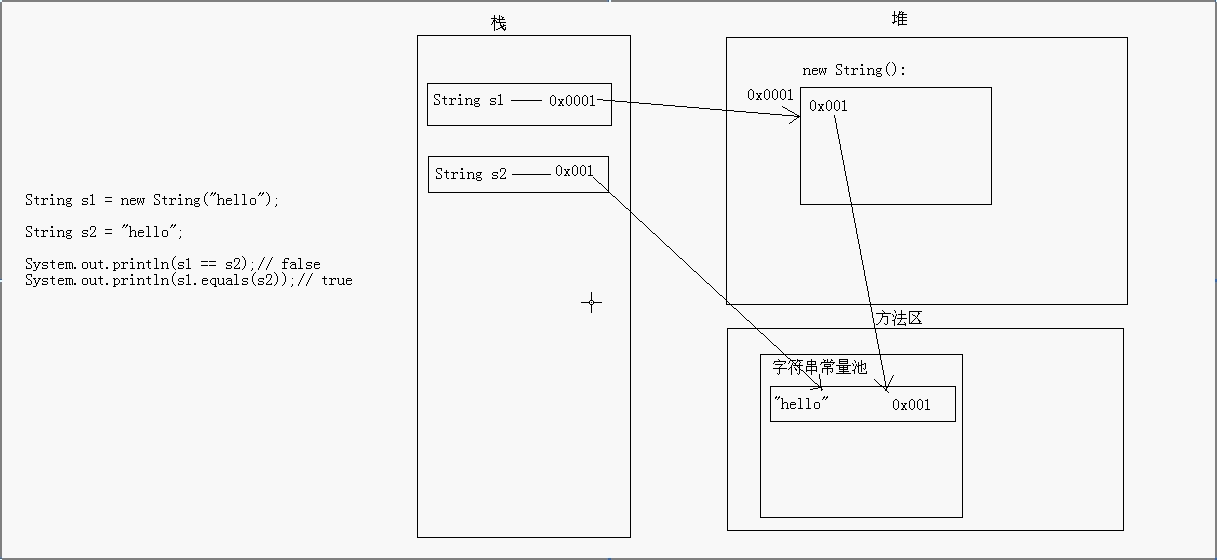概述
字符串:就是由多个字符组成的一串数据。也可以看成是一个字符数组。
通过查看API,我们可以知道
A:字符串字面值"abc"也可以看成是一个字符串对象。
B:字符串是常量,一旦被赋值,就不能被改变。
构造方法:
public String():空构造
public String(byte[] bytes):把字节数组转成字符串
public String(byte[] bytes,int index,int length):把字节数组的一部分转成字符串
public String(char[] value):把字符数组转成字符串
public String(char[] value,int index,int count):把字符数组的一部分转成字符串
public String(String original):把字符串常量值转成字符串
字符串的方法:
public int length():返回此字符串的长度。
package cn.itcast_01;
public class StringDemo {
public static void main(String[] args) {
// public String():空构造
String s1 = new String();
System.out.println("s1:" + s1);
System.out.println("s1.length():" + s1.length());
System.out.println("--------------------------");
// public String(byte[] bytes):把字节数组转成字符串
byte[] bys = { 97, 98, 99, 100, 101 };
String s2 = new String(bys);
System.out.println("s2:" + s2);
System.out.println("s2.length():" + s2.length());
System.out.println("--------------------------");
// public String(byte[] bytes,int index,int length):把字节数组的一部分转成字符串
// 我想得到字符串"bcd"
String s3 = new String(bys, 1, 3);
System.out.println("s3:" + s3);
System.out.println("s3.length():" + s3.length());
System.out.println("--------------------------");
// public String(char[] value):把字符数组转成字符串
char[] chs = { 'a', 'b', 'c', 'd', 'e', '爱', '林', '亲' };
String s4 = new String(chs);
System.out.println("s4:" + s4);
System.out.println("s4.length():" + s4.length());
System.out.println("--------------------------");
// public String(char[] value,int index,int count):把字符数组的一部分转成字符串
String s5 = new String(chs, 2, 4);
System.out.println("s5:" + s5);
System.out.println("s5.length():" + s5.length());
System.out.println("--------------------------");
//public String(String original):把字符串常量值转成字符串
String s6 = new String("abcde");
System.out.println("s6:" + s6);
System.out.println("s6.length():" + s6.length());
System.out.println("--------------------------");
//字符串字面值"abc"也可以看成是一个字符串对象。
String s7 = "abcde";
System.out.println("s7:"+s7);
System.out.println("s7.length():"+s7.length());
}
}
/*
s1:
s1.length():0
--------------------------
s2:abcde
s2.length():5
--------------------------
s3:bcd
s3.length():3
--------------------------
s4:abcde爱林亲
s4.length():8
--------------------------
s5:cde爱
s5.length():4
--------------------------
s6:abcde
s6.length():5
--------------------------
s7:abcde
s7.length():5
*/String特点及面试题
一旦被赋值,就不能改变
package cn.itcast_02;
/*
* 字符串的特点:一旦被赋值,就不能改变。
*/
public class StringDemo {
public static void main(String[] args) {
String s = "hello";
s += "world";
System.out.println("s:" + s); // helloworld
}
}
/*
s:helloworld
*/面试题
面试题1
String s = new String(“hello”)和String s = “hello”;的区别?
有。前者会创建2个对象,后者创建1个对象。
==:比较引用类型比较的是地址值是否相同
equals:比较引用类型默认也是比较地址值是否相同,而String类重写了equals()方法,比较的是内容是否相同。
public class StringDemo2 {
public static void main(String[] args) {
String s1 = new String("hello");
String s2 = "hello";
System.out.println(s1 == s2);// false
System.out.println(s1.equals(s2));// true
}
}面试题2
package cn.itcast_02;
/*
* 看程序写结果
*/
public class StringDemo3 {
public static void main(String[] args) {
String s1 = new String("hello");
String s2 = new String("hello");
System.out.println(s1 == s2);
System.out.println(s1.equals(s2));
String s3 = new String("hello");
String s4 = "hello";
System.out.println(s3 == s4);
System.out.println(s3.equals(s4));
String s5 = "hello";
String s6 = "hello";
System.out.println(s5 == s6);
System.out.println(s5.equals(s6));
}
}
/*
false
true
false
true
true
true
*/面试题3
package cn.itcast_02;
/*
* 看程序写结果
* 字符串如果是变量相加,先开空间,在拼接。
* 字符串如果是常量相加,是先加,然后在常量池找,如果有就直接返回,否则,就创建。
*/
public class StringDemo4 {
public static void main(String[] args) {
String s1 = "hello";
String s2 = "world";
String s3 = "helloworld";
System.out.println(s3 == s1 + s2);// false
System.out.println(s3.equals((s1 + s2)));// true
System.out.println(s3 == "hello" + "world");// false 这个我们错了,应该是true
System.out.println(s3.equals("hello" + "world"));// true
// 通过反编译看源码,我们知道这里已经做好了处理。
// System.out.println(s3 == "helloworld");
// System.out.println(s3.equals("helloworld"));
}
}String判断功能
boolean equals(Object obj):比较字符串的内容是否相同,区分大小写
boolean equalsIgnoreCase(String str):比较字符串的内容是否相同,忽略大小写
boolean contains(String str):判断大字符串中是否包含小字符串
boolean startsWith(String str):判断字符串是否以某个指定的字符串开头
boolean endsWith(String str):判断字符串是否以某个指定的字符串结尾
boolean isEmpty():判断字符串是否为空。
注意:
字符串内容为空和字符串对象为空。
String s = "";
String s = null;
package cn.itcast_03;
public class StringDemo {
public static void main(String[] args) {
// 创建字符串对象
String s1 = "helloworld";
String s2 = "helloworld";
String s3 = "HelloWorld";
// boolean equals(Object obj):比较字符串的内容是否相同,区分大小写
System.out.println("equals:" + s1.equals(s2));
System.out.println("equals:" + s1.equals(s3));
System.out.println("-----------------------");
// boolean equalsIgnoreCase(String str):比较字符串的内容是否相同,忽略大小写
System.out.println("equals:" + s1.equalsIgnoreCase(s2));
System.out.println("equals:" + s1.equalsIgnoreCase(s3));
System.out.println("-----------------------");
// boolean contains(String str):判断大字符串中是否包含小字符串
System.out.println("contains:" + s1.contains("hello"));
System.out.println("contains:" + s1.contains("hw"));
System.out.println("-----------------------");
// boolean startsWith(String str):判断字符串是否以某个指定的字符串开头
System.out.println("startsWith:" + s1.startsWith("h"));
System.out.println("startsWith:" + s1.startsWith("hello"));
System.out.println("startsWith:" + s1.startsWith("world"));
System.out.println("-----------------------");
// 练习:boolean endsWith(String str):判断字符串是否以某个指定的字符串结尾这个自己玩
// boolean isEmpty():判断字符串是否为空。
System.out.println("isEmpty:" + s1.isEmpty());
String s4 = "";
String s5 = null;
System.out.println("isEmpty:" + s4.isEmpty());
// NullPointerException
// s5对象都不存在,所以不能调用方法,空指针异常
System.out.println("isEmpty:" + s5.isEmpty());
}
}
/*
equals:true
equals:false
-----------------------
equals:true
equals:true
-----------------------
contains:true
contains:false
-----------------------
startsWith:true
startsWith:true
startsWith:false
-----------------------
isEmpty:false
isEmpty:true
Exception in thread "main" java.lang.NullPointerException
at cn.itcast_03.StringDemo.main(StringDemo.java:55)
*/String类的获取功能
int length():获取字符串的长度。
char charAt(int index):获取指定索引位置的字符
int indexOf(int ch):返回指定字符在此字符串中第一次出现处的索引。
为什么这里是int类型,而不是char类型?
原因是:'a'和97其实都可以代表'a'
int indexOf(String str):返回指定字符串在此字符串中第一次出现处的索引。
int indexOf(int ch,int fromIndex):返回指定字符在此字符串中从指定位置后第一次出现处的索引。
int indexOf(String str,int fromIndex):返回指定字符串在此字符串中从指定位置后第一次出现处的索引。
String substring(int start):从指定位置开始截取字符串,默认到末尾。
String substring(int start,int end):从指定位置开始到指定位置结束截取字符串。
package cn.itcast_04;
public class StringDemo {
public static void main(String[] args) {
// 定义一个字符串对象
String s = "helloworld";
// int length():获取字符串的长度。
System.out.println("s.length:" + s.length());
System.out.println("----------------------");
// char charAt(int index):获取指定索引位置的字符
System.out.println("charAt:" + s.charAt(7));
System.out.println("----------------------");
// int indexOf(int ch):返回指定字符在此字符串中第一次出现处的索引。
System.out.println("indexOf:" + s.indexOf('l'));
System.out.println("----------------------");
// int indexOf(String str):返回指定字符串在此字符串中第一次出现处的索引。
System.out.println("indexOf:" + s.indexOf("owo"));
System.out.println("----------------------");
// int indexOf(int ch,int fromIndex):返回指定字符在此字符串中从指定位置后第一次出现处的索引。
System.out.println("indexOf:" + s.indexOf('l', 4));
System.out.println("indexOf:" + s.indexOf('k', 4)); // -1
System.out.println("indexOf:" + s.indexOf('l', 40)); // -1
System.out.println("----------------------");
// 自己练习:int indexOf(String str,int
// fromIndex):返回指定字符串在此字符串中从指定位置后第一次出现处的索引。
// String substring(int start):从指定位置开始截取字符串,默认到末尾。包含start这个索引
System.out.println("substring:" + s.substring(5));
System.out.println("substring:" + s.substring(0));
System.out.println("----------------------");
// String substring(int start,int
// end):从指定位置开始到指定位置结束截取字符串。包括start索引但是不包end索引
System.out.println("substring:" + s.substring(3, 8));
System.out.println("substring:" + s.substring(0, s.length()));
}
}
/*
s.length:10
----------------------
charAt:r
----------------------
indexOf:2
----------------------
indexOf:4
----------------------
indexOf:8
indexOf:-1
indexOf:-1
----------------------
substring:world
substring:helloworld
----------------------
substring:lowor
substring:helloworld
*/String的转换功能
byte[] getBytes():把字符串转换为字节数组。
char[] toCharArray():把字符串转换为字符数组。
static String valueOf(char[] chs):把字符数组转成字符串。
static String valueOf(int i):把int类型的数据转成字符串。
注意:String类的valueOf方法可以把任意类型的数据转成字符串。
String toLowerCase():把字符串转成小写。
String toUpperCase():把字符串转成大写。
String concat(String str):把字符串拼接。
package cn.itcast_05;
public class StringDemo {
public static void main(String[] args) {
// 定义一个字符串对象
String s = "JavaSE";
// byte[] getBytes():把字符串转换为字节数组。
byte[] bys = s.getBytes();
for (int x = 0; x < bys.length; x++) {
System.out.println(bys[x]);
}
System.out.println("----------------");
// char[] toCharArray():把字符串转换为字符数组。
char[] chs = s.toCharArray();
for (int x = 0; x < chs.length; x++) {
System.out.println(chs[x]);
}
System.out.println("----------------");
// static String valueOf(char[] chs):把字符数组转成字符串。
String ss = String.valueOf(chs);
System.out.println(ss);
System.out.println("----------------");
// static String valueOf(int i):把int类型的数据转成字符串。
int i = 100;
String sss = String.valueOf(i);
System.out.println(sss);
System.out.println("----------------");
// String toLowerCase():把字符串转成小写。
System.out.println("toLowerCase:" + s.toLowerCase());
System.out.println("s:" + s);
// System.out.println("----------------");
// String toUpperCase():把字符串转成大写。
System.out.println("toUpperCase:" + s.toUpperCase());
System.out.println("----------------");
// String concat(String str):把字符串拼接。
String s1 = "hello";
String s2 = "world";
String s3 = s1 + s2;
String s4 = s1.concat(s2);
System.out.println("s3:"+s3);
System.out.println("s4:"+s4);
}
}String类的其他功能
替换功能:
String replace(char old,char new)
String replace(String old,String new)
去除字符串两空格
String trim()
按字典顺序比较两个字符串
int compareTo(String str)
int compareToIgnoreCase(String str)
public class StringDemo {
public static void main(String[] args) {
// 替换功能
String s1 = "helloworld";
String s2 = s1.replace('l', 'k');
String s3 = s1.replace("owo", "ak47");
System.out.println("s1:" + s1);
System.out.println("s2:" + s2);
System.out.println("s3:" + s3);
System.out.println("---------------");
// 去除字符串两空格
String s4 = " hello world ";
String s5 = s4.trim();
System.out.println("s4:" + s4 + "---");
System.out.println("s5:" + s5 + "---");
// 按字典顺序比较两个字符串
String s6 = "hello";
String s7 = "hello";
String s8 = "abc";
String s9 = "xyz";
System.out.println(s6.compareTo(s7));// 0
System.out.println(s6.compareTo(s8));// 7
System.out.println(s6.compareTo(s9));// -16
}
}练习题
练习题1
package cn.itcast_03;
import java.util.Scanner;
/*
* 模拟登录,给三次机会,并提示还有几次。如果登录成功,就可以玩猜数字小游戏了。
*
* 分析:
* A:定义用户名和密码。已存在的。
* B:键盘录入用户名和密码。
* C:比较用户名和密码。
* 如果都相同,则登录成功
* 如果有一个不同,则登录失败
* D:给三次机会,用循环改进,最好用for循环。
*/
public class StringTest2 {
public static void main(String[] args) {
// 定义用户名和密码。已存在的。
String username = "admin";
String password = "admin";
// 给三次机会,用循环改进,最好用for循环。
for (int x = 0; x < 3; x++) {
// x=0,1,2
// 键盘录入用户名和密码。
Scanner sc = new Scanner(System.in);
System.out.println("请输入用户名:");
String name = sc.nextLine();
System.out.println("请输入密码:");
String pwd = sc.nextLine();
// 比较用户名和密码。
if (name.equals(username) && pwd.equals(password)) {
// 如果都相同,则登录成功
System.out.println("登录成功,开始玩游戏");
//猜数字游戏
GuessNumberGame.start();
break;
} else {
// 如果有一个不同,则登录失败
// 2,1,0
// 如果是第0次,应该换一种提示
if ((2 - x) == 0) {
System.out.println("帐号被锁定,请与班长联系");
} else {
System.out.println("登录失败,你还有" + (2 - x) + "次机会");
}
}
}
}
}练习题2
package cn.itcast_04;
/*
* 需求:遍历获取字符串中的每一个字符
*
* 分析:
* A:如何能够拿到每一个字符呢?
* char charAt(int index)
* B:我怎么知道字符到底有多少个呢?
* int length()
*/
public class StringTest {
public static void main(String[] args) {
// 定义字符串
String s = "helloworld";
// 原始版本
// System.out.println(s.charAt(0));
// System.out.println(s.charAt(1));
// System.out.println(s.charAt(2));
// System.out.println(s.charAt(3));
// System.out.println(s.charAt(4));
// System.out.println(s.charAt(5));
// System.out.println(s.charAt(6));
// System.out.println(s.charAt(7));
// System.out.println(s.charAt(8));
// System.out.println(s.charAt(9));
// 只需要我们从0取到9
// for (int x = 0; x < 10; x++) {
// System.out.println(s.charAt(x));
// }
// 如果长度特别长,我不可能去数,所以我们要用长度功能
for (int x = 0; x < s.length(); x++) {
// char ch = s.charAt(x);
// System.out.println(ch);
// 仅仅是输出,我就直接输出了
System.out.println(s.charAt(x));
}
}
}
练习题3
package cn.itcast_04;
/*
* 需求:统计一个字符串中大写字母字符,小写字母字符,数字字符出现的次数。(不考虑其他字符)
* 举例:
* "Hello123World"
* 结果:
* 大写字符:2个
* 小写字符:8个
* 数字字符:3个
*
* 分析:
* 前提:字符串要存在
* A:定义三个统计变量
* bigCount=0
* smallCount=0
* numberCount=0
* B:遍历字符串,得到每一个字符。
* length()和charAt()结合
* C:判断该字符到底是属于那种类型的
* 大:bigCount++
* 小:smallCount++
* 数字:numberCount++
*
* 这道题目的难点就是如何判断某个字符是大的,还是小的,还是数字的。
* ASCII码表:
* 0 48
* A 65
* a 97
* 虽然,我们按照数字的这种比较是可以的,但是想多了,有比这还简单的
* char ch = s.charAt(x);
*
* if(ch>='0' && ch<='9') numberCount++
* if(ch>='a' && ch<='z') smallCount++
* if(ch>='A' && ch<='Z') bigCount++
* D:输出结果。
*
* 练习:把给定字符串的方式,改进为键盘录入字符串的方式。
*/
public class StringTest2 {
public static void main(String[] args) {
//定义一个字符串
String s = "Hello123World";
//定义三个统计变量
int bigCount = 0;
int smallCount = 0;
int numberCount = 0;
//遍历字符串,得到每一个字符。
for(int x=0; x<s.length(); x++){
char ch = s.charAt(x);
//判断该字符到底是属于那种类型的
if(ch>='a' && ch<='z'){
smallCount++;
}else if(ch>='A' && ch<='Z'){
bigCount++;
}else if(ch>='0' && ch<='9'){
numberCount++;
}
}
//输出结果。
System.out.println("大写字母"+bigCount+"个");
System.out.println("小写字母"+smallCount+"个");
System.out.println("数字"+numberCount+"个");
}
}练习题4
package cn.itcast_05;
/*
* 需求:把一个字符串的首字母转成大写,其余为小写。(只考虑英文大小写字母字符)
* 举例:
* helloWORLD
* 结果:
* Helloworld
*
* 分析:
* A:先获取第一个字符
* B:获取除了第一个字符以外的字符
* C:把A转成大写
* D:把B转成小写
* E:C拼接D
*/
public class StringTest {
public static void main(String[] args) {
// 定义一个字符串
String s = "helloWORLD";
// 先获取第一个字符
String s1 = s.substring(0, 1);
// 获取除了第一个字符以外的字符
String s2 = s.substring(1);
// 把A转成大写
String s3 = s1.toUpperCase();
// 把B转成小写
String s4 = s2.toLowerCase();
// C拼接D
String s5 = s3.concat(s4);
System.out.println(s5);
// 优化后的代码
// 链式编程
String result = s.substring(0, 1).toUpperCase()
.concat(s.substring(1).toLowerCase());
System.out.println(result);
}
}
练习题5
package cn.itcast_07;
/*
* 需求:把数组中的数据按照指定个格式拼接成一个字符串
* 举例:
* int[] arr = {1,2,3};
* 输出结果:
* "[1, 2, 3]"
* 分析:
* A:定义一个字符串对象,只不过内容为空
* B:先把字符串拼接一个"["
* C:遍历int数组,得到每一个元素
* D:先判断该元素是否为最后一个
* 是:就直接拼接元素和"]"
* 不是:就拼接元素和逗号以及空格
* E:输出拼接后的字符串
*
* 把代码用功能实现。
*/
public class StringTest2 {
public static void main(String[] args) {
// 前提是数组已经存在
int[] arr = { 1, 2, 3 };
// 写一个功能,实现结果
String result = arrayToString(arr);
System.out.println("最终结果是:" + result);
}
/*
* 两个明确: 返回值类型:String 参数列表:int[] arr
*/
public static String arrayToString(int[] arr) {
// 定义一个字符串
String s = "";
// 先把字符串拼接一个"["
s += "[";
// 遍历int数组,得到每一个元素
for (int x = 0; x < arr.length; x++) {
// 先判断该元素是否为最后一个
if (x == arr.length - 1) {
// 就直接拼接元素和"]"
s += arr[x];
s += "]";
} else {
// 就拼接元素和逗号以及空格
s += arr[x];
s += ", ";
}
}
return s;
}
}
练习题6
package cn.itcast_07;
import java.util.Scanner;
/*
* 字符串反转
* 举例:键盘录入”abc”
* 输出结果:”cba”
*
* 分析:
* A:键盘录入一个字符串
* B:定义一个新字符串
* C:倒着遍历字符串,得到每一个字符
* a:length()和charAt()结合
* b:把字符串转成字符数组
* D:用新字符串把每一个字符拼接起来
* E:输出新串
*/
public class StringTest3 {
public static void main(String[] args) {
// 键盘录入一个字符串
Scanner sc = new Scanner(System.in);
System.out.println("请输入一个字符串:");
String line = sc.nextLine();
/*
// 定义一个新字符串
String result = "";
// 把字符串转成字符数组
char[] chs = line.toCharArray();
// 倒着遍历字符串,得到每一个字符
for (int x = chs.length - 1; x >= 0; x--) {
// 用新字符串把每一个字符拼接起来
result += chs[x];
}
// 输出新串
System.out.println("反转后的结果是:" + result);
*/
// 改进为功能实现
String s = myReverse(line);
System.out.println("实现功能后的结果是:" + s);
}
/*
* 两个明确: 返回值类型:String 参数列表:String
*/
public static String myReverse(String s) {
// 定义一个新字符串
String result = "";
// 把字符串转成字符数组
char[] chs = s.toCharArray();
// 倒着遍历字符串,得到每一个字符
for (int x = chs.length - 1; x >= 0; x--) {
// 用新字符串把每一个字符拼接起来
result += chs[x];
}
return result;
}
}
练习题7
package cn.itcast_07;
/*
* 统计大串中小串出现的次数
* 举例:
* 在字符串"woaijavawozhenaijavawozhendeaijavawozhendehenaijavaxinbuxinwoaijavagun"
* 结果:
* java出现了5次
*
* 分析:
* 前提:是已经知道了大串和小串。
*
* A:定义一个统计变量,初始化值是0
* B:先在大串中查找一次小串第一次出现的位置
* a:索引是-1,说明不存在了,就返回统计变量
* b:索引不是-1,说明存在,统计变量++
* C:把刚才的索引+小串的长度作为开始位置截取上一次的大串,返回一个新的字符串,并把该字符串的值重新赋值给大串
* D:回到B
*/
public class StringTest5 {
public static void main(String[] args) {
// 定义大串
String maxString = "woaijavawozhenaijavawozhendeaijavawozhendehenaijavaxinbuxinwoaijavagun";
// 定义小串
String minString = "java";
// 写功能实现
int count = getCount(maxString, minString);
System.out.println("Java在大串中出现了:" + count + "次");
}
/*
* 两个明确: 返回值类型:int 参数列表:两个字符串
*/
public static int getCount(String maxString, String minString) {
// 定义一个统计变量,初始化值是0
int count = 0;
/*
// 先在大串中查找一次小串第一次出现的位置
int index = maxString.indexOf(minString);
// 索引不是-1,说明存在,统计变量++
while (index != -1) {
count++;
// 把刚才的索引+小串的长度作为开始位置截取上一次的大串,返回一个新的字符串,并把该字符串的值重新赋值给大串
// int startIndex = index + minString.length();
// maxString = maxString.substring(startIndex);
maxString = maxString.substring(index + minString.length());
// 继续查
index = maxString.indexOf(minString);
}
*/
int index;
//先查,赋值,判断
while((index=maxString.indexOf(minString))!=-1){
count++;
maxString = maxString.substring(index + minString.length());
}
return count;
}
}
























 1万+
1万+

 被折叠的 条评论
为什么被折叠?
被折叠的 条评论
为什么被折叠?








